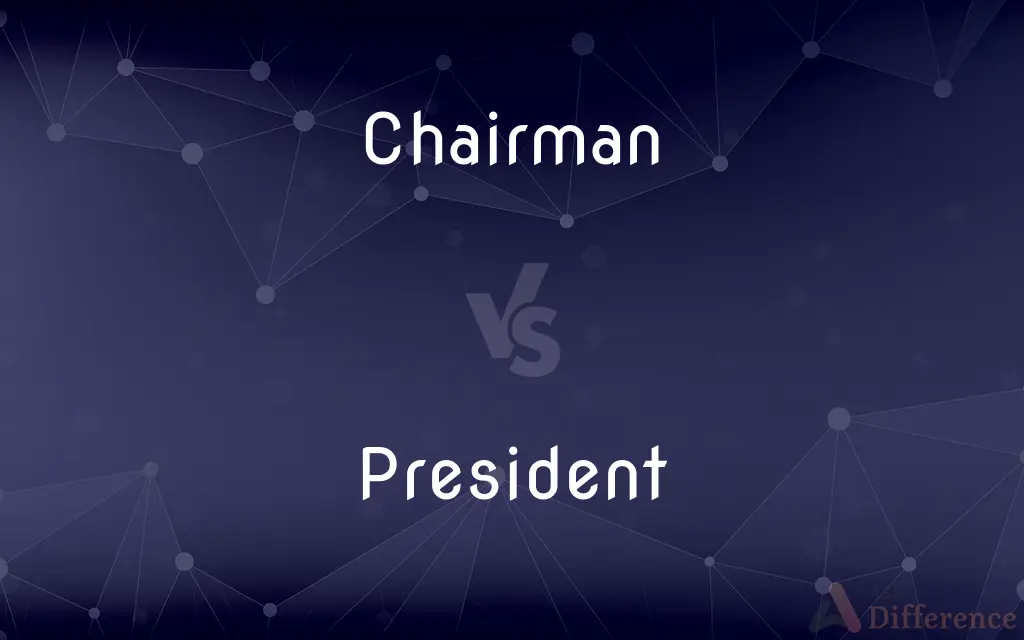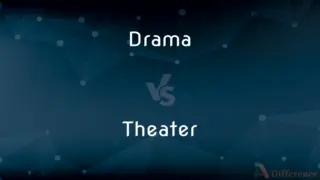Chairman vs. President — What's the Difference?
By Tayyaba Rehman & Fiza Rafique — Updated on March 13, 2024
A chairman leads board meetings, while a president oversees an organization's daily operations.

Difference Between Chairman and President
Table of Contents
ADVERTISEMENT
Key Differences
The chairman is a key figure in the governance structure of an organization, typically responsible for presiding over meetings of the board of directors. This role is crucial for ensuring that the board's decisions are made in an orderly and efficient manner. On the other hand, the president of an organization usually holds a senior executive role, with a primary focus on the management and day-to-day operations of the company.
The chairman often represents the board to the public and shareholders, maintaining a focus on governance and strategic oversight. The president is often seen as the face of the company, responsible for executing the strategies and policies set by the board, managing senior staff, and ensuring operational efficiency.
While the chairman focuses on leading the board in setting long-term strategies and governance policies, the president is deeply involved in the operational aspects, working towards achieving the strategic goals established by the board. This distinction underscores the complementary nature of their roles, with the chairman providing direction and the president executing on that direction.
In some organizations, the roles of chairman and president may be held by different individuals to ensure a balance of power and to enhance governance. In others, especially in smaller companies or in less formal structures, one person might hold both titles, blending strategic oversight with operational management. This dual role can streamline decision-making but may also raise concerns about the concentration of power.
The interaction between the chairman and the president is pivotal for the success of any organization. The chairman, with a focus on governance, works closely with the board to provide strategic direction, while the president, as the chief executive, translates this direction into actionable plans and leads the execution. This dynamic ensures that both governance and operational excellence are aligned towards the organization's goals.
ADVERTISEMENT
Comparison Chart
Primary Role
Leads the board of directors
Oversees daily operations
Focus
Governance and strategic oversight
Execution of strategies and operational management
Authority Level
High in governance structure
High in executive structure
Responsibilities
Presiding over board meetings, representing board
Managing operations, executing board strategies
Interaction
With board members and shareholders
With employees, stakeholders, and sometimes the public
Compare with Definitions
Chairman
Acts as a liaison between the board and the CEO or president.
The chairman discussed the board's expectations with the president after the meeting.
President
Acts under the board's strategic guidance, executing policies and strategies.
Following board directives, the president launched a new product line.
Chairman
Leads board meetings and sets agendas.
The chairman prepared an agenda focused on sustainability initiatives.
President
May also serve on the board, providing a link between governance and operations.
As president and a board member, she ensured that operational decisions aligned with the board's strategic vision.
Chairman
Represents the board to shareholders and the public.
The chairman addressed shareholder concerns during the annual meeting.
President
Often considered the face of the company, especially in operational contexts.
The president represented the company at the industry conference.
Chairman
The head of a board of directors, overseeing governance and strategic direction.
The chairman called the meeting to order, focusing on the strategic plan.
President
Coordinates with various departments to ensure goals are met.
The president held a meeting with department heads to discuss quarterly targets.
Chairman
Primarily concerned with governance and policy setting.
As chairman, he ensures that the board's policies are adhered to by the organization.
President
The senior executive responsible for managing the organization's daily operations.
The president introduced new operational efficiencies to cut costs.
Chairman
The presiding officer of an assembly, meeting, committee, or board.
President
One appointed or elected to preside over an organized body of people, such as an assembly or meeting.
Chairman
The administrative head of a department of instruction, as at a college.
President
The chief executive of a republic.
Chairman
To act as chairman of
Chaired the panel of experts.
President
The chief executive officer of the United States, with powers as determined by the US Constitution.
Chairman
A person presiding over a meeting.
President
The chief officer of a branch of government, corporation, board of trustees, university, or similar body.
Chairman
The head of a corporate or governmental board of directors, a committee, or other formal entity.
President
The head of state of a republic.
The vast majority of presidents have been male.
Chairman
(historical) Someone whose job is to carry people in a portable chair, sedan chair, or similar conveyance.
President
In presidential republics, the head of government and head of state.
Chairman
To serve as chairman.
President
Primary leader of a corporation. Not to be confused with CEO, which is a related but separate position that is sometimes held by a different person.
Chairman
The presiding officer of a committee, or of a public or private meeting, or of any organized body.
President
A person presiding over a meeting; a chair, presiding officer, presider.
Chairman
One whose business it is to cary a chair or sedan.
Breaks watchmen's heads and chairmen's glasses.
President
Obsolete form of precedent
Chairman
The officer who presides at the meetings of an organization;
Address your remarks to the chairperson
President
(archaic) Occupying the first rank or chief place; having the highest authority; presiding.
Chairman
Act or preside as chair, as of an academic department in a university;
She chaired the department for many years
President
To act as president; to do presidential duties.
President
Precedent.
President
One who is elected or appointed to preside; a presiding officer, as of a legislative body.
President
A protector; a guardian; a presiding genius.
Just Apollo, president of verse.
President
Occupying the first rank or chief place; having the highest authority; presiding.
His angels presidentIn every province.
President
An executive officer of a firm or corporation
President
The person who holds the office of head of state of the United States government;
The President likes to jog every morning
President
The chief executive of a republic
President
The officer who presides at the meetings of an organization;
Address your remarks to the chairperson
President
The head administrative officer of a college or university
President
The office of the United States head of state;
A President is elected every four years
Common Curiosities
What are the responsibilities of a chairman?
The chairman presides over board meetings, represents the board to shareholders, and ensures governance and strategic oversight.
What does a president do in an organization?
The president oversees the organization's operations, implements strategies, and manages senior staff.
How do the roles of chairman and president interact?
They work together, with the chairman providing governance and strategic direction and the president executing these strategies operationally.
Can the same person be both chairman and president?
Yes, in some organizations, one person may hold both titles, though it's less common in larger entities due to governance concerns.
Is the chairman or the president higher in the corporate hierarchy?
The chairman is higher in the governance hierarchy, while the president is higher in the operational and executive hierarchy.
Do all companies have both a chairman and a president?
Not all; the structure depends on the company's size, industry, and governance model.
What is the main difference between a chairman and a president?
The chairman leads the board and focuses on governance, while the president manages daily operations.
Can a chairman fire the president?
The chairman, with the board's approval, can typically initiate the removal of a president based on governance structures.
What skills are important for a chairman?
Leadership, strategic thinking, governance knowledge, and communication skills are crucial for a chairman.
How do shareholders interact with the chairman and president?
Shareholders typically interact with the chairman regarding governance issues and with the president for operational inquiries.
How often do the chairman and president meet?
Frequency varies but often includes regular board meetings and as needed for strategic discussions.
What qualifications should a president have?
Operational expertise, leadership, strategic execution, and industry knowledge are key for a president.
What is the role of a president in a non-profit organization?
Similar to for-profits, focusing on daily management and execution of the board's strategies.
What happens if there is a conflict between the chairman and the president?
Conflicts are usually resolved through board intervention, aligning both roles towards the organization's best interests.
How do the roles vary across different countries?
Roles and titles may vary, with some countries adopting different terms or structures for similar functions.
Share Your Discovery

Previous Comparison
Mansionette vs. Mansion
Next Comparison
Drama vs. TheaterAuthor Spotlight
Written by
Tayyaba RehmanTayyaba Rehman is a distinguished writer, currently serving as a primary contributor to askdifference.com. As a researcher in semantics and etymology, Tayyaba's passion for the complexity of languages and their distinctions has found a perfect home on the platform. Tayyaba delves into the intricacies of language, distinguishing between commonly confused words and phrases, thereby providing clarity for readers worldwide.
Co-written by
Fiza RafiqueFiza Rafique is a skilled content writer at AskDifference.com, where she meticulously refines and enhances written pieces. Drawing from her vast editorial expertise, Fiza ensures clarity, accuracy, and precision in every article. Passionate about language, she continually seeks to elevate the quality of content for readers worldwide.















































